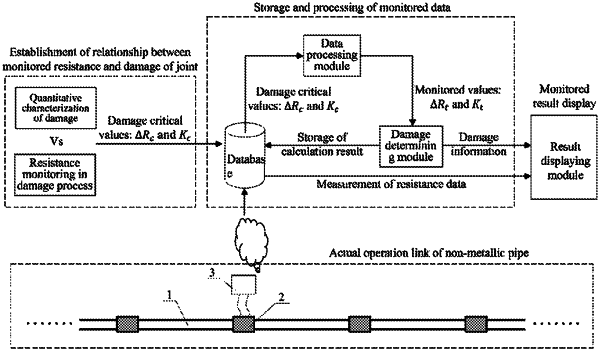| CPC G01N 3/066 (2013.01) [G01N 3/12 (2013.01); G01N 2203/0067 (2013.01); G01N 2203/0296 (2013.01); G01N 2203/0617 (2013.01)] | 18 Claims |

|
1. A system for monitoring damage of electrofusion joints of a non-metallic pipe, the system comprising:
a data collector connected to an electrofusion joint of the non-metallic pipe through a pair of monitoring electrodes and configured to collect monitored resistance data of a body material of the electrofusion joint between the pair of monitoring electrodes, wherein the pair of monitoring electrodes is bonded to a surface of the electrofusion joint of the non-metallic pipe;
one or more processors; and
one or more memories coupled to the one or more processors and having instructions stored thereon that are executable by the one or more processors to perform one or more operations comprising:
obtaining a first damage critical value, a second damage critical value, and the monitored resistance data collected by the data collector;
processing the monitored resistance data to obtain a first monitored value and a second monitored value, wherein the first monitored value and the second monitored value are real-time monitored values and respectively correspond to the first damage critical value and the second damage critical value;
comparing the first monitored value with the first damage critical value and comparing the second monitored value with the second damage critical value; and
determining that the electrofusion joint is damaged in response to determining: the first monitored value being greater than the first damage critical value and the second monitored value being greater than the second damage critical value,
wherein the first damage critical value and the second damage critical value are different values selected from a plurality of characteristic values comprising:
a monitored resistance value of the electrofusion joint on damage, indicating a resistance value of the electrofusion joint monitored when damage occurs to the electrofusion joint,
a change value of monitored resistance of the electrofusion joint on damage, indicating a value obtained by subtracting an initial resistance value from the monitored resistance value of the electrofusion joint when damage occurs to the electrofusion joint,
a change rate of monitored resistance value of the electrofusion joint on damage, indicating a ratio between an absolute change value of monitored resistance of the electrofusion joint when damage occurs to the electrofusion joint and the initial resistance value, and
a slope change rate of relative change curve of monitored resistance of the electrofusion joint on damage, indicating a ratio between slopes of a relative change curve of monitored resistances of the electrofusion joint within two time periods respectively before and after a time when damage occurs to the electrofusion joint,
wherein the first damage critical value and the second damage critical value are determined based on a monitored resistance change curve of one or more electrofusion joint specimens and an internal pressure value on damage of electrofusion joint specimens,
wherein the internal pressure value on damage of the electrofusion joint specimens is determined based on a damage degree-internal pressure curve, where the damage degree-internal pressure curve quantitatively represents a damage degree of the electrofusion joint specimens after an internal pressure is loaded,
 where Di represents a damage degree of the electrofusion joint specimen after an internal pressure of i MPa is loaded, Pi represents a bearing strength of the electrofusion joint specimen after the internal pressure of i MPa is loaded, and Pmax represents a maximum bearing strength of the electrofusion joint specimen without damage, and
wherein the monitored resistance change curve of the electrofusion joint specimen is obtained by applying an internal pressure load to the electrofusion joint specimen and accordingly recording monitored resistance value data of the electrofusion joint specimen, and wherein the monitored resistance value data at least comprises an initial resistance value, a resistance value on damage, and resistance change values within a plurality of time periods between an initial time and a damage time when damage occurs to the electrofusion joint specimen.
|